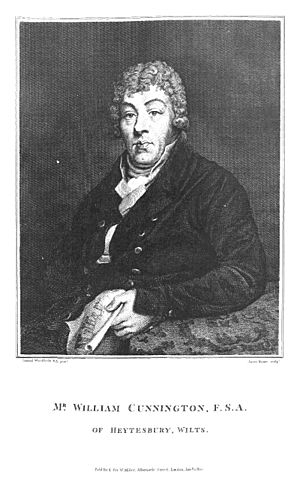William Cunnington facts for kids

William Cunnington III (born 1754, died 1810) was an English expert in old things, known as an archaeologist. He was one of the first people to dig up ancient sites carefully.
A Passion for the Past
William Cunnington was a merchant who taught himself about history. He became very interested in the ancient sites around Heytesbury, a village in Wiltshire, England. Unlike most people at the time, he understood that to truly learn about old burial mounds, called barrows, they needed to be dug up and studied carefully.
He started his archaeological work around 1798. At first, he paid for his own digs. Soon, rich people became interested in his work and helped him with money. These supporters included Henry Penruddocke Wyndham and, most importantly, Sir Richard Colt Hoare.
Digging Up History
Sir Richard Colt Hoare gave Cunnington a lot of money starting in 1804. This allowed Cunnington to dig up hundreds of barrows across south Wiltshire. His digging methods were simple compared to today's standards. He mostly dug a shaft, or narrow trench, from the top of a mound down to the ground. He was looking for interesting "novelties" or finds.
Even though his methods were basic, Cunnington was a true pioneer. He was the first archaeologist to do such a large amount of digging. It wasn't until the 1840s that new, better digging methods were developed by Thomas Bateman in Derbyshire.
Cunnington's Team
William Cunnington worked with Stephen and John Parker, who were also from Heytesbury. They helped him on almost all his digs until 1810. Cunnington trusted them as careful and experienced diggers. John Parker is often mentioned in letters between Cunnington and Hoare.
It seems John Parker often traveled across the Wiltshire Downs to find new sites. John, born in 1780, was seen as hard-working and excited about the discoveries. He would be very disappointed if a dig didn't find anything interesting. Recent studies show that Cunnington wrote a letter in 1808 describing John Parker using a trowel. This is the first known mention of a trowel being used on an archaeological site, at Bush Barrow.
Cunnington's Legacy
William Cunnington and Sir Richard Colt Hoare were featured in an exhibition at the Wiltshire Museum in 2003. The museum keeps Cunnington's old papers and notes. It also has watercolor drawings made by Philip Crocker and the ancient objects that Cunnington dug up.

